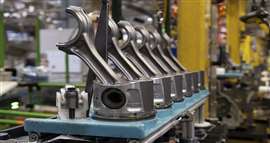Cummins collaborates on engine-improving steel alloy
19 June 2023
Cummins Inc. and Oak Ridge National Laboratory (ORNL) have developed a new high-temperature steel alloy that Cummins said will increase the durability and efficiency of its engines. Cooperative development of the new alloy was supported by the Department of Energy’s Vehicle Technologies Office LightMAT Program.
 A long-term engine test of pistons manufactured from the new material exhibited no cracking and very little oxidation or scaling. (Photo: Cummins)
A long-term engine test of pistons manufactured from the new material exhibited no cracking and very little oxidation or scaling. (Photo: Cummins)
Established in 1943 as part of the Manhattan Project, ORNL conducts research and development focused on the interrelated areas of advanced combustion engines, lubricants, fuels, and emissions controls. It has a staff of more than 6,000, including scientists and engineers in more than 100 disciplines.
The collaborative project between Cummins and ORNL was started in 2018 to research and develop an alternative steel alloy with significantly improved high-temperature oxidation resistance and strength, while maintaining affordability. Cummins noted that previous materials have limited engine efficiency gains and emissions reductions, and prohibited engineers from extracting more heat from the combustion process, due to premature degradation from oxidation, scaling and cracking.
The new material is significantly stronger at elevated temperatures compared to 4140, the most commonly used commercial steel, and has virtually eliminated degradation pathways, Cummins said. By comparison, tests showed the novel steel alloy exhibited 85% greater Ultimate Tensile Strength (maximum stress a material can withstand while being stretched or pulled before breaking) and 143% greater fatigue strength (maximum cyclical stress that can be applied for the material to withstand at least 10 million cycles before failure) at 600° C compared to 4140 steel.
An aggressive, long-term engine test of pistons manufactured from the new material exhibited no cracking and very little oxidation or scaling, Cummins reported. Compared to current 4140 steels, the new medium carbon steel also showed at least a 50° C increase in temperature capability, the company added.
In announcing the development, Corey Trobaugh, Cummins director - Applied Science and Technology, commented: “The partnership with Oak Ridge National Laboratory and development of the new material shows the serious potential for improvements and efficiencies for our engines. I am extremely proud of the value of work our team has provided and the future improvement it lends.”
STAY CONNECTED




Receive the information you need when you need it through our world-leading magazines, newsletters and daily briefings.
POWER SOURCING GUIDE
The trusted reference and buyer’s guide for 83 years
The original “desktop search engine,” guiding nearly 10,000 users in more than 90 countries it is the primary reference for specifications and details on all the components that go into engine systems.
Visit Now
CONNECT WITH THE TEAM










